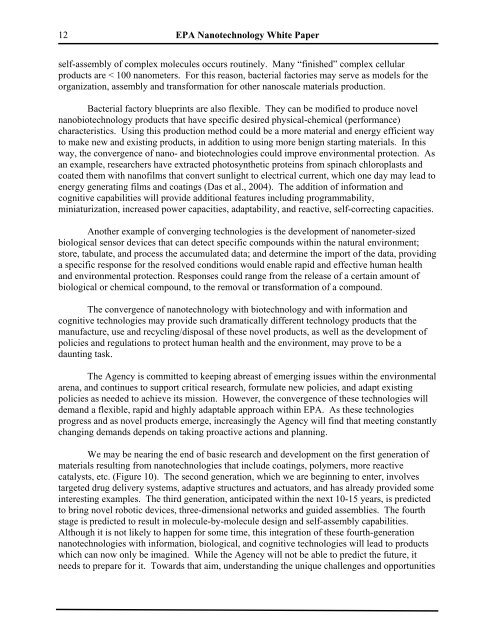Nanotechnology White Paper - US Environmental Protection Agency
Nanotechnology White Paper - US Environmental Protection Agency
Nanotechnology White Paper - US Environmental Protection Agency
You also want an ePaper? Increase the reach of your titles
YUMPU automatically turns print PDFs into web optimized ePapers that Google loves.
12 EPA <strong>Nanotechnology</strong> <strong>White</strong> <strong>Paper</strong><br />
self-assembly of complex molecules occurs routinely. Many “finished” complex cellular<br />
products are < 100 nanometers. For this reason, bacterial factories may serve as models for the<br />
organization, assembly and transformation for other nanoscale materials production.<br />
Bacterial factory blueprints are also flexible. They can be modified to produce novel<br />
nanobiotechnology products that have specific desired physical-chemical (performance)<br />
characteristics. Using this production method could be a more material and energy efficient way<br />
to make new and existing products, in addition to using more benign starting materials. In this<br />
way, the convergence of nano- and biotechnologies could improve environmental protection. As<br />
an example, researchers have extracted photosynthetic proteins from spinach chloroplasts and<br />
coated them with nanofilms that convert sunlight to electrical current, which one day may lead to<br />
energy generating films and coatings (Das et al., 2004). The addition of information and<br />
cognitive capabilities will provide additional features including programmability,<br />
miniaturization, increased power capacities, adaptability, and reactive, self-correcting capacities.<br />
Another example of converging technologies is the development of nanometer-sized<br />
biological sensor devices that can detect specific compounds within the natural environment;<br />
store, tabulate, and process the accumulated data; and determine the import of the data, providing<br />
a specific response for the resolved conditions would enable rapid and effective human health<br />
and environmental protection. Responses could range from the release of a certain amount of<br />
biological or chemical compound, to the removal or transformation of a compound.<br />
The convergence of nanotechnology with biotechnology and with information and<br />
cognitive technologies may provide such dramatically different technology products that the<br />
manufacture, use and recycling/disposal of these novel products, as well as the development of<br />
policies and regulations to protect human health and the environment, may prove to be a<br />
daunting task.<br />
The <strong>Agency</strong> is committed to keeping abreast of emerging issues within the environmental<br />
arena, and continues to support critical research, formulate new policies, and adapt existing<br />
policies as needed to achieve its mission. However, the convergence of these technologies will<br />
demand a flexible, rapid and highly adaptable approach within EPA. As these technologies<br />
progress and as novel products emerge, increasingly the <strong>Agency</strong> will find that meeting constantly<br />
changing demands depends on taking proactive actions and planning.<br />
We may be nearing the end of basic research and development on the first generation of<br />
materials resulting from nanotechnologies that include coatings, polymers, more reactive<br />
catalysts, etc. (Figure 10). The second generation, which we are beginning to enter, involves<br />
targeted drug delivery systems, adaptive structures and actuators, and has already provided some<br />
interesting examples. The third generation, anticipated within the next 10-15 years, is predicted<br />
to bring novel robotic devices, three-dimensional networks and guided assemblies. The fourth<br />
stage is predicted to result in molecule-by-molecule design and self-assembly capabilities.<br />
Although it is not likely to happen for some time, this integration of these fourth-generation<br />
nanotechnologies with information, biological, and cognitive technologies will lead to products<br />
which can now only be imagined. While the <strong>Agency</strong> will not be able to predict the future, it<br />
needs to prepare for it. Towards that aim, understanding the unique challenges and opportunities

















